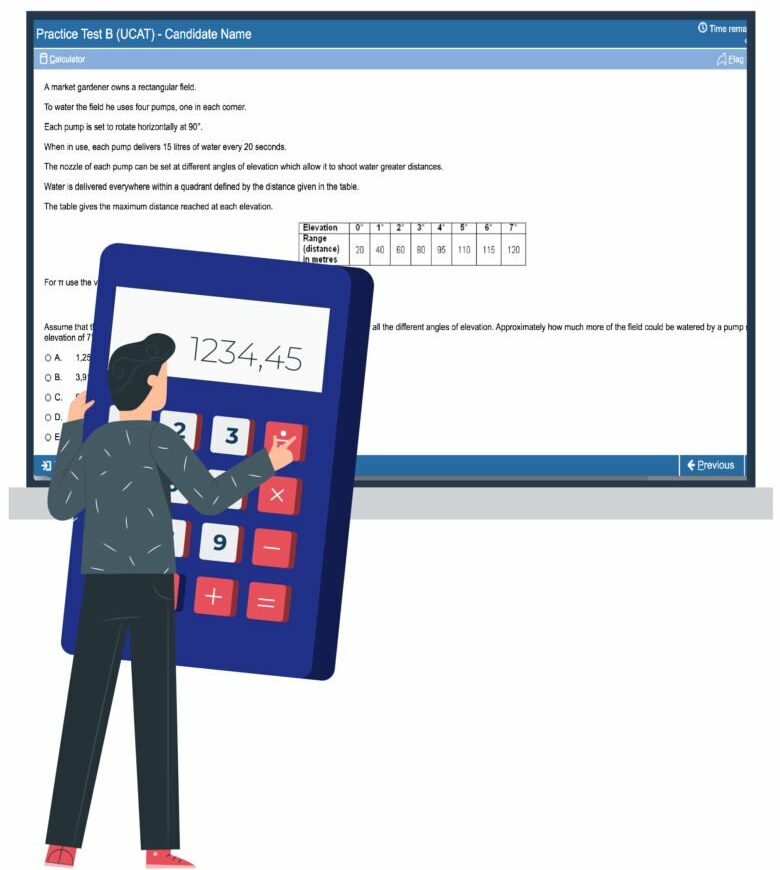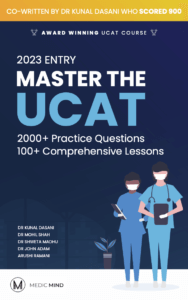The UCAT’s final section is Situational Judgement. It examines how you will respond in clinical or business circumstances in particular. This section is the last section and is the least time-constrained. However, it is important to not assume that it is easier or less significant than the other sections! Most UCAT universities have a cut-off score for the UCAT SJT section when considering medical school applicants. Most do not accept students scoring Band 4, so you must make sure you do not overlook this section! However, do not worry too much. You can succeed with your preparation in this section if you follow the 10 situational judgement test tips in this article!
1. Situational Judgement section: Make sure you look at the GMC guidance
Many students find that trial and error is the best way to learn how to do the Situational Judgement UCAT section. Doing practice questions is indeed an excellent way to practise for the UCAT. Although it is essential to master the theory before doing so. Doing so would help you have a solid foundation before attempting some practice questions, allowing you to have a more effective revision.
A great source for this theory is the GMC, the General Medical Council in the UK. They are the governing board that establishes the professional criteria that UK doctors and medical students must meet, among other things. The GMC’s published guidelines is a major source of inspiration for the Situational Judgement section answers. this is because the UCAT is used for admission to NHS UK medical schools.
Hence, you should read and understand the GMC guidelines before anything else. When reviewing their guidelines, it may be helpful to make your own document to summarise this. This is because the paper is pretty lengthy. Therefore, doing so would allow you to have a summary sheet that you can always refer to as you practise or revise. Try to refer to the document less and less when you are doing practice questions. Only look at it again when you are revising for the actual examination.
Additionally, the GMC has provided advice for medical students. It is more specifically suited to problems you could run across while in medical school. However, this covers the same concepts as the original document. This will be the case in many of the cases provided to you, so it is also a useful supplement for you to review.

2. Situational Judgement Section: Understand the options
The options in the UCAT’s Situational Judgement Testing questions can be very similar to each other, which makes it very difficult for you to choose between them. Discerning between the options is very confusing. But to do so, you must comprehend the meaning of all the options in order to select the appropriate response. Hence, here is a description of one of the most common question formats:
- A very appropriate thing to do means it addresses the main problem in the stem without negative consequences
- Appropriate, but not ideal, means that whilst it solves one of the issues in the stem, it is not the most ideal solution
- Inappropriate, but not awful, means that it has transient negative consequences
- A very inappropriate thing to do means it either does not address the problem at all or actively makes the issue worse
3. Situational Judgement Section: Use the ‘rule of 3’ when reading the question
The “rule of 3” refers to the three key considerations you should have in mind when answering the question. Which are:
- Role: What is your role in this scenario? How a doctor reacts to a situation is very different to how a medical student may be expected to act. Therefore, note down your role and react accordingly.
- Setting: How one responds to a scenario depends on the setting of the problem. For example, it is always best to have personal conversations with a colleague in private and so doing this in public would be inappropriate.
- Main problem: Most scenarios will have more than one issue that needs solving. Find the main one and focus on solving it in the most appropriate manner.
4. Always keep the patient at the forefront of your decision-making
In medicine, consideration of patient safety is crucial when making decisions. Patient safety is not only restricted to the health and physical safety of the subject, it also includes the protection of the privacy of their information (i.e.; confidentiality). Options that disregard these are frequently deemed as inappropriate. Similarly, in situations where patient safety is at stake, even if it is presented amongst other issues, the compromise of patient safety should be identified as the main problem. The 4 pillars of medical ethics might be useful for determining what is best for patients. They are:
- Beneficence – “do good”. Consider if your actions benefit the patient
- Non-Maleficence – “do no harm”. Consider if your actions are causing the patient harm and how to avoid this
- Autonomy – allowing the patient to make their own decisions and respecting them
- Justice – treat all patients equally and in consideration of the law
5. Do not neglect the Situational Judgement section
As mentioned, some students treat this section more lightly compared to the rest because it is the last section and they have run out of stamina.
However, it is crucial to remember that the Situational Judgement section is still a deciding factor at many universities. That being said, certain universities place a higher priority on the UCAT SJT bands than others. If you have a low score (most commonly regarded as Band 4 scores), certain universities will not accept your application, Other universities emphasise the UCAT situational judgement bands more, and will use it as a component of the MMI interview process. Be sure to research the institutions you have selected and learn how much is taken into account.
Regardless of how much the SJT portion is valued by your top universities, it is crucial that you do not neglect studying for it. As long as you do well in this portion, you will have as many possibilities as you can when applying.
Additionally, your SJT result is reported separately as a “banding score” in addition to your UCAT total or average numerical score/ Therefore, it is the only score that you cannot conceal behind your UCAT average.
It is helpful to become familiar with this as well, because this portion has a different scoring system than the other sections. The table below summarises all the possible UCAT Situational Judgement bands you are able to get.
| Band 1 | Performed at an excellent level, displaying judgement similar to the majority of the expert panel. |
| Band 2 | Displayed a decent level of performance, often demonstrating appropriate judgement, with several responses corresponding to model answers. |
| Band 3 | Performed at a modest level, displaying appropriate judgement for some questions and significant differences from model responses for other questions. |
| Band 4 | Performed poorly, displaying significantly different judgement than the model response in several cases. |
6. Search for resources carefully
Tests of situational judgement are utilised by clinicians at all stages of training throughout their medical careers. For example, situational judgement exams are employed at university, during the foundation years, and even after you specialise. Therefore, if you are seeking for the questions most relevant to your revision, be sure to search for “Situational Judgement UCAT.” Because there are so many options available, you need to be sure the ones you are practising on are acceptable. You do not want to wind up taking an exam in cardiology!
In addition, various sources will explain their answers to the Situational Judgement questions that they provide. As a result, it is crucial to only use formal resources and tutors in your revision. Our instructors have had first-hand experience with the SJT at various stages in their careers. Medic Mind’s one-on-one SJT tuition may be useful. Check us out here!

7. Analyse the rationale properly
It is crucial to understand the logic behind the correct responses when you are practising. Even if you have answered correctly, you should still ensure that your initial reasoning matches that provided by the official source. Furthermore, a book or question bank that does not provide appropriate justifications for the questions may not be the best resource to help you prepare. If this is the case, you can attempt to refer back to the GMC advice and see how your specific issue fits there to draw your own justifications.
You will notice that some themes and rules appear more frequently than others as you complete more scenarios. You should use this as a guide when answering SJT questions! For instance, unless there is an immediate threat to someone’s safety, you should always choose to resolve inter-professional conflicts locally (i.e., with the individual in question) before escalating it to higher-ups.
If you still have trouble understanding explanations, one-on-one tutoring could be helpful. All of our instructors have worked for the NHS and are familiar with GMC regulations, so they can provide knowledgeable guidance.
8. Prepare for the full length of the test
During the Situational Judgement part, many students start to lose their intellectual energy. This is because it is the final section of the UCAT, and students would have already put all of their effort into answering the previous questions and focused all their revision efforts in those sections instead. As a result, they do poorly in this last section, affecting their score. Keep in mind that this section’s score is recorded individually; it serves no use to receive 900 (the highest possible score) in all other sections, but to receive a Band 4 in this one.

Make sure that on exam day, this does not take place to you. Make sure to take practice examinations that are as long as the actual UCAT so you can develop the endurance necessary to finish the test on time. Remember to extend your practice time if you are given extra time during the exam.
9. Timing tips
The least time-sensitive component is this one. You have the luxury of time to thoroughly read each question to make sure you do not miss any important information. Use the 26 minutes you have to answer 69 questions in the Situational Judgement segment wisely. Be cautious not to rush and to consider your responses thoroughly. That being said, you should strike a balance and also avoid becoming comfortable because the exam is still ongoing.

This highlights once more how crucial it is to not neglect this test section and to prepare for it. You will only be able to settle into a rhythm when answering the questions if you practice and get ready for it. Additionally, by being aware of your average response time, you can gauge whether you are answering questions too slowly or too quickly on the actual test day itself.
10. Do not be too indecisive
During Situational Judgement, some students may deliberate excessively and switch back and forth between possible answers. In this case, it is important to be aware of how the Situational Judgement is marked – just for acquiring the proper side (a/ b or c/ d), you will receive a half-mark. Hence, while you should not rush, you should also try not to take too long to choose between, say, options a or b. If this is something you struggle with, practice will be quite beneficial. It will enable you to become used to the question type and comprehend the ethics behind the questions. When you are comfortable with both of these concepts, you will be able to answer the questions with assurance and speed.
Finally, preserve your composure and keep your self-worth distinct from your score as you do with everything else relating to medical school applications. In the end, applying to medical school is a very comprehensive process so your prospects are not entirely determined by one bad test result.
We hope you’ve found these UCAT situational judgement tips helpful. Best of luck!
FAQs
What is UCAT SJT?
One of the five subtests included in the UCAT exam, the Situational Judgement Test (SJT) is used to select candidates for admission to medical schools. It is meant to gauge a candidate’s aptitude for comprehending and approaching real-world circumstances as well as situations that a doctor or medical student could run across.
How is UCAT SJT scored?
Depending on your total score, a band is assigned to you. The bands range from Band 1 (the highest) and Band 4 (the lowest). In 2020, only 9% of applicants earned a Band 4, compared to 30% who received a Band 1. For further information, see our UCAT scoring guide here.





Still got a question? Leave a comment